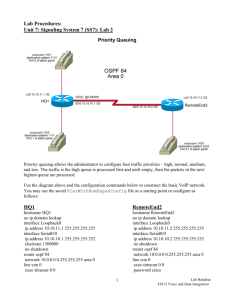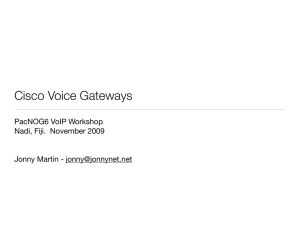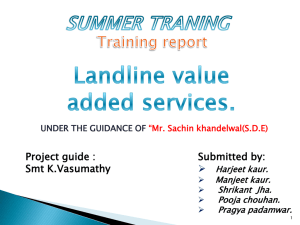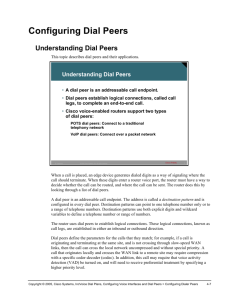Dial Plans - IT, Sligo
advertisement
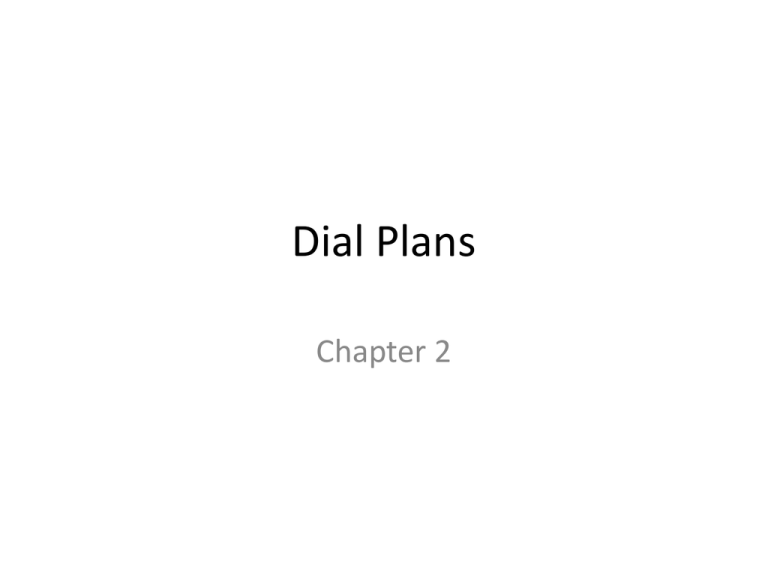
Dial Plans Chapter 2 Dial and Numbering Plans • A numbering plan describes the endpoint addressing in a telephony network • Same as IP addressing in an IP network • There are private and public numbering plans – the same as private and public IP addressing schemes • Dial plans present the biggest challenge to a VoIP network administrator! Dial Plans • Dial plans analyze, screen and route calls based on dialled digits. • Dial plans specify how to interpret digit sequences dialled by the user. • Dial plans convert those into an outbound dial string. • On Cisco voice gateways, dial plans must be manually configured • They are basically a collection of dialled peers Problems • Unlike IP addresses a caller can input any combination of numbers from a dial. • A wrong IP address can be dropped immediately but dialled digits must be analysed. • There are a few possibilities for destinations; Destinations or Peers • • • • • Local VoIP phone extension number Local POTS phone number (FXS port) Local POTS exchange number (FXO port) Distant VoIP extension number (WAN) Distant POTS number (WAN) Caution • You are expected to be able to establish a connection with emergency services from a VoIP extension. • You also must provide access to all other services such as free-phone low-call etc.. • You are expected to bar certain Peers • You are expected to limit certain extensions capabilities Public Numbering Plans • • • • • • • • Emergency services Directory services Local calling Mobile calling Long-distance calling Toll-free calling International calling Premium calling National Numbering Plan • • • • • • • • 00 – International 071 – Regional area code 071 - 91 – City area code!! 18 – Free call and Low call 08 – Mobile network 15 – Premium rate service 112 or 999 – Emergency service 11811 – Directory enquiries (note similarity with 112 service) Private Numbering Plans • Is used within a single organization • Several factors need to be considered when designing such a numbering plan 1. Number of addressable devices 2. Number of locations 3. Methods of assigning site codes 4. Inbound call routing 5. External (PSTN) call routing Scalable Dial Plans a) b) c) d) e) Logical distribution Hierarchical numbering plan Provisioning simplicity Reduction in post-dial delay Fault Tolerance a) Logical Distribution • Local gateway should handle details that are specific to its function • High level routing decisions should be passed on to Gatekeepers and PBX systems b) Hierarchical numbering plan • Simplifies provisioning tasks • Simplifies call routing by keeping local calls local and using access code for long distance • Provides summarization by providing groups of numbers in different locations • Adds scalability • Simplifies management – can be controlled from a central point c) Provisioning simplicity • Avoid overlapping numbering plans and extension ranges • Use digit manipulation where desired to standardize number patterns d) Reduction in post-dial delay • Users of PSTN have little or no post-dial delay • Minimize the number of dial peers and translations • The more translations and lookups – the longer the post-dial delay e) Fault Tolerance • For critical sites, redundant gateways can be implemented. • Alternate routes should be available • This is usually established in the network design anyway Digit Manipulation • • • • • • Digit stripping Forwarding dialled digits Adding prefixes to dialled numbers Manipulating Caller ID Number expansion Voice translation profiles Examples of Dial Peers Voice Gateway Router Configuration File voice-port 1/0/0 ! voice-port 1/0/1 ! dial-peer voice 1 pots destination-pattern 5551234 port 1/0/0 dial-peer voice 2 pots destination-pattern 5555678 port 1/0/1 Voice Gateway Router 1 Configuration voice-port 1/0/0 ! dial-peer voice 1 pots destination-pattern 5551234 port 1/0/0 ! dial-peer voice 10 voip destination-pattern 5555678 session target ipv4:10.5.6.7 codec g711ulaw Voice Gateway Router 1 Configuration File voice-port 1/0/0 ! dial-peer voice 1 pots destination-pattern 5551234 port 1/0/0 ! dial-peer voice 2 voip destination-pattern 5555678 session target ipv4:10.5.6.7 Voice Gateway Router 2 Configuration File voice-port 1/0/0 ! dial-peer voice 1 pots destination-pattern 5555678 port 1/0/0 ! dial-peer voice 2 voip destination-pattern 5551234 session target ipv4:10.2.3.4 Digit stripping (default) Forwarding dialled digits Other Examples - Communication Between Dial Peers Sharing the Same Router Matching call legs to Dial-Peers Dial Peers from the perspective of the both routers Figure 6 - Sample VoIP Network Three telephone numbers in the sales branch office need dial peers configured for them. Router B is the primary gateway to the main office; as such, it needs to be connected to the company's PBX. Four devices need dial peers, all of which are connected to the PBX, configured for them in the main office. Dial Peer Configuration Table for Sample Voice over IP Network in Figure 6
